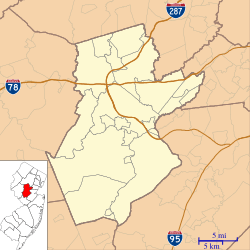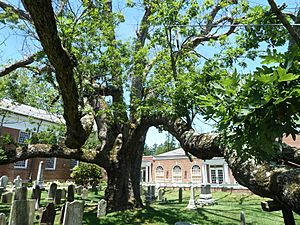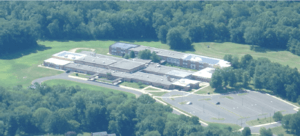Basking Ridge, New Jersey facts for kids
Quick facts for kids
Basking Ridge, New Jersey
|
|
|---|---|

Street scene in Basking Ridge
|
|
| Country | |
| State | |
| County | Somerset |
| Township | Bernards |
| Area | |
| • Total | 6.80 sq mi (17.60 km2) |
| • Land | 6.75 sq mi (17.48 km2) |
| • Water | 0.05 sq mi (0.12 km2) |
| Elevation | 335 ft (102 m) |
| Population
(2020)
|
|
| • Total | 7,196 |
| • Density | 1,066.07/sq mi (411.60/km2) |
| Time zone | UTC−05:00 (Eastern (EST)) |
| • Summer (DST) | UTC−04:00 (Eastern (EDT)) |
| ZIP Code |
07920, 07939
|
| Area code(s) | 908 |
| FIPS code | 34-03340 |
| GNIS feature ID | 2806230 |
Basking Ridge is an unincorporated community and census-designated place (CDP) located within Bernards Township in the Somerset Hills region of Somerset County, in the U.S. state of New Jersey.
Settled during colonial times, Basking Ridge is in the Raritan Valley and is a commercial hub for northern-central New Jersey and is a commuter town of New York City. It was home to the old AT&T Headquarters, now operated by Verizon. Basking Ridge is the current headquarters for Collabera, Verizon Wireless, Peraton Labs, Lawyer.com, and Barnes & Noble College Booksellers. The community also hosts a train station along the Gladstone Branch (one of the two branches of the Morris & Essex Lines), which connects to Hoboken Terminal and New York Penn Station.
The community of Basking Ridge is part of greater Bernards Township, which also includes the neighborhoods of Liberty Corner, Lyons and West Millington.
It was first listed as a CDP in the 2020 census with a population of 7,196.
Contents
History
Basking Ridge was originally settled in the 1720s by British Presbyterians escaping religious persecution. The land was bought from the Lenape Native Americans.
Bernards Township was officially chartered on May 21, 1760, granted by King George II and granted to Sir Francis Bernard, first governor of the noted section which includes Basking Ridge.
On the morning of December 13, 1776, General Charles Lee was captured by the British at Widow White's tavern. Lee had ranked next to Washington in command.
A referendum to create an independent borough of Basking Ridge failed in June 1921. Voters rejected the proposed borough by a more than 4–1 margin.
The downtown area of Bernards Township known as Basking Ridge was added to the New Jersey and National Registries as a Historic District. on August 8, 1974.
Demographics
| Historical population | |||
|---|---|---|---|
| Census | Pop. | %± | |
| 2020 | 7,196 | — | |
| U.S. Decennial Census 2020 |
|||
2020 census
| Race / Ethnicity | Pop 2020 | % 2020 |
|---|---|---|
| White alone (NH) | 5,666 | 78.74% |
| Black or African American alone (NH) | 46 | 0.64% |
| Native American or Alaska Native alone (NH) | 1 | 0.01% |
| Asian alone (NH) | 671 | 9.32% |
| Pacific Islander alone (NH) | 0 | 0.00% |
| Other Race alone (NH) | 21 | 0.29% |
| Mixed Race/Multi-Racial (NH) | 272 | 3.78% |
| Hispanic or Latino (any race) | 519 | 7.21% |
| Total | 7,196 | 100.00% |
Prior to 2020, demographic data was based on the United States Census Bureau figures for the ZIP Code Tabulation Area (ZCTA) for the 07920 ZIP Code. As of the 2010 census, the population for the ZIP Code Tabulation Area (ZCTA) 07920 was 26,747.
Arts and culture
Cultural events
Basking Ridge has an annual event in May called Charter Day. Many rides are set up in the Oak Street field—a bounce house, inflatable race tracks, and spinning rides. Also, in the center of the town hundreds of stands are set up mostly promoting school sports, but there are also many kettle corn stands, which is a traditional food children eat during Charter Day. At night, the traditional Battle of the Bands takes place, which many teenagers sign up for to play their favorite songs.
Historic sites
- Basking Ridge was home to the Old Oak Tree, a 600-year-old white oak, perhaps the oldest white oak in the world. The tree was located on the historic graveyard of the local Presbyterian church. The tree was 97 feet (30 m) high and had a trunk circumference of 20 feet (6.1 m) and its lower branches were supported. In 2016 the tree showed signs of distress as its upper parts failed to sprout leaves. A big portion of the tree was cut down in 2017 due to decay. The tree has since been cut down as of April 26, 2017.
- A specially designed experimental hospital was built in 1779 by local resident John "Rebel Banker" Morton with the help of Dr. James Tilton in the winter of 1779-80. The hospital was built with three wards, that held patients in its hub and each of the three wards held eight patients. Patient beds were oriented so that their heads were closest to the walls of the buildings. When temperatures fell, a "fire was built in the midst of the ward, without any chimney, and the smoke circulating about, passed off through an opening about 4 inches wide in the ridge of the roof." Tilton described how the design of the building allowed infection to be fought using smoke, "without giving the least offense to the patient, for it always rose above their heads, before it spread abroad in the ward." This hospital, which could accommodate up to 55 patients, provided an uncrowded but fully ventilated space in which those with infectious disease could be kept apart from those who were wounded.
- The Bernards Township Municipal Hall was once owned by the Astors. The estate was built in 1912 by Samuel Owen of Newark, New Jersey.
- The Brick Academy was built in 1809 as the Basking Ridge Classical School; its function was to prepare young men for the College of New Jersey (now known as Princeton University). It has also served as a public school, a union hall, a public library, and the municipal hall for Bernards Township. It now serves as a historic museum for Basking Ridge and as the home of The Historical Society of the Somerset Hills.
- The Van Dorn Mill was built in 1768 as a wooden structure; it was rebuilt in 1843 with foundations extending 20 feet (6.1 m) below ground level, using thousands of stones hauled from the hedgerows of nearby farms.
- The Basking Ridge Presbyterian Church is a Greek Revival church built in 1839 and expanded in 1869, that is listed on the New Jersey Register of Historic Places and added to the National Register of Historic Places on December 31, 1974.
- The Warren Kinney Memorial Oak Tree commemorates the life of a well-known dairy farmer and community leader from New Vernon, NJ. According to Mr. Kinney's 1975 obituary, he "helped lead a fight to prevent a jetport from being built on the Great Swamp Wildlife Refuge in Morris County," and was "a founding member of the Madison Square Club, and trustee of the New York Zoological Society."
- The Devil's Tree is a solitary oak with some dead limbs growing in an undeveloped field on Mountain Road, opposite Emerald Valley Lane. Local legend, documented in Weird NJ magazine and the book based on it, tells that the tree is cursed or the property of the Devil and has been a site of lynchings by the Ku Klux Klan in the past.
- Alward Farm House is a Colonial era farmhouse representing the simple lifestyle of early settlers. Built c.1740, it is one of the first structures in Bernards Township. Entered in State and National Registers, 1986.
National Register of Historic Places
Basking Ridge has several properties on the National Register of Historic Places.
- Alward Farmhouse, added March 13, 1986
- Basking Ridge Classical School, added July 21, 1976
- Coffee House, added November 7, 1977
- Presbyterian Church in Basking Ridge, added December 31, 1974
- Lord Stirling Manor Site, added June 22, 1978
- Basking Ridge Historic District, added August 8, 1974.
Parks and recreation
There are several parks within Basking Ridge. Four are county parks: Lord Stirling Park, Rebel Hill, Southard, and Harry Dunham. The fifth is Pleasant Valley Park which contains the town pool and miles of woodchip trails.
Education
Bernards High School was founded by the Bernards Township Board of Education in 1924. When Bernardsville separated from Bernards Township, the schools still remained one system until 1947 when the original high school became the property of Bernardsville. From 1948, however, township students continued attending Bernards High School as tuition students. In 1960 a contract was issued for the construction of a new Ridge High School and Cedar Hill School which were built on approximately 60 acres (24 ha) of land.
William Annin Middle School was originally named after a colonial patriot who settled in Basking Ridge in 1722. Construction started in 1968 and the school was dedicated on September 28, 1969, as William Annin Junior High School and contained grades 6 through 8. The following year it shifted to grades 7 through 9. It became a middle school in 1982. It currently contains grades 6 through 8. The school is one of the few in the United States to have a seismograph.
There are four elementary schools in Basking Ridge.
- Liberty Corner School, was built for a farming community in 1905. It is the oldest school in the district. Part of the original building still remains today. It is located in the Liberty Corner section of Bernards Township.
- Oak Street School was built in 1938, although it was completed late. It was dedicated on November 21, 1939, and opened on November 23, the day before Thanksgiving. Dr. Horatio Gates Whitnall originally owned the property on which Oak Street School was built. The land was used for farming and his home was what is now the Summit Bank. Over the years, the population rose rapidly. It serves downtown Basking Ridge which is the area around the Presbyterian Church and the Old Oak Tree.
- Cedar Hill School was built 1956. It is situated on land which was once the property of a succession of wealthy families: Owen, Lee, Bissell, and Astor. It was donated in the Mid 1950s by the Lees. It serves the area around William Annin Middle School and Ridge High School.
- Mount Prospect was built in 1999. The school was built because a new population rolled in by 2000. Basking Ridge was extended southward and a new subdivision was built: The Hills. Mount Prospect is the newest school in the district and serves the Hills.
- The former Maple Avenue School, a two-story, eight classroom structure, was demolished in the 1970s to make room for the current Basking Ridge Public Library.
Transportation
Trains
NJ Transit's Gladstone Branch runs through Basking Ridge. There are two stations that residents can use to get to New York City and Hoboken Terminal:
- Basking Ridge: Built in 1912 by the Delaware, Lackawanna and Western Railroad, it serves downtown and north Basking Ridge.
- Lyons: Built in 1931 by the Delaware, Lackawanna and Western Railroad, it serves the Hills, and south Basking Ridge in addition to Liberty Corner. Lyons gets more passengers than Basking Ridge.
Buses
Lakeland Bus Lines (Route 78) provides service to and from the Port Authority Bus Terminal in Midtown Manhattan during peak commuting hours.
Roads and highways
Two Interstates are located near Basking Ridge:
- Interstate 78: Travel west towards Pennsylvania or east towards New York City and Newark
- Interstate 287: Travel north towards upstate New York or south towards Edison.
Notable people
People who were born in, residents of, or otherwise closely associated with Basking Ridge include:
- J. C. Chandor (born 1974), Academy award-nominated writer/director of the 2011 film Margin Call.
- Chris Daggett (born 1950), former regional administrator of the United States Environmental Protection Agency and Commissioner of the New Jersey Department of Environmental Protection who ran for Governor of New Jersey in 2009 as an independent.
- Marc Del Gaizo (born 1999), professional ice hockey defenseman for the Nashville Predators of the National Hockey League
- Scott Fischer (1955–1996), climber and guide who was the first American to climb Lhotse, the fourth-highest mountain in the world. He died on May 11, 1996, in an attempt to climb Mount Everest in the 1996 Everest Disaster.
- Patricia Lee Gauch (born 1934), author of over 30 works of children's literature who was inducted into the New Jersey Literary Hall of Fame in 1993.
- Jeff Grace, comedian, screenwriter, film producer, film director and actor, who directed Folk Hero & Funny Guy.
- Jon Gutwillig (born 1974), guitarist of the Disco Biscuits.
- Tobin Heath (born 1988), 2x World Cup Champion and 2x Olympic gold medalist soccer player with the United States women's national team.
- Vincent R. Kramer (1918–2001), United States Marine Corps colonel who was a guerrilla warfare expert and was awarded the Navy Cross during the Korean War.
- Peter Kuhn (1955–2009), race car driver who won both the USAC and SCCA Formula Super Vee championships in 1980.
- Philip Lindsley (1786–1855), Presbyterian minister, educator, and classicist who served as the acting president of the College of New Jersey (now Princeton University) from 1822 to 1824.
- Page McConnell (born 1963), keyboardist best known for his work with Phish.
- Robert E. Mulcahy III (born 1932), former athletic director at Rutgers University.
- Akshay Nanavati (born 1984), United States Marine Corps veteran, speaker, entrepreneur, ultra runner and author of Fearvana.
- Edmund Perry (1825–1878), politician and newspaper publisher, who served as President of the New Jersey Senate from 1861 to 1862
- Jasbir Puar (born 1967), queer theorist, Professor of Women and Gender Studies at Rutgers University and author of The Right to Maim.
- Perry Scott (1917–1988), American football player and coach, who played in the NFL for the Detroit Lions
- Samuel Lewis Southard (1787–1842), served as U.S. Senator, Secretary of the Navy, and the 10th Governor of New Jersey.
- Meryl Streep (born 1949), multiple Oscar-winning actress
- LaDainian Tomlinson (born 1979), former NFL running back who played for the San Diego Chargers.
- The founding members of punk rock band The Bouncing Souls grew up in Basking Ridge.












